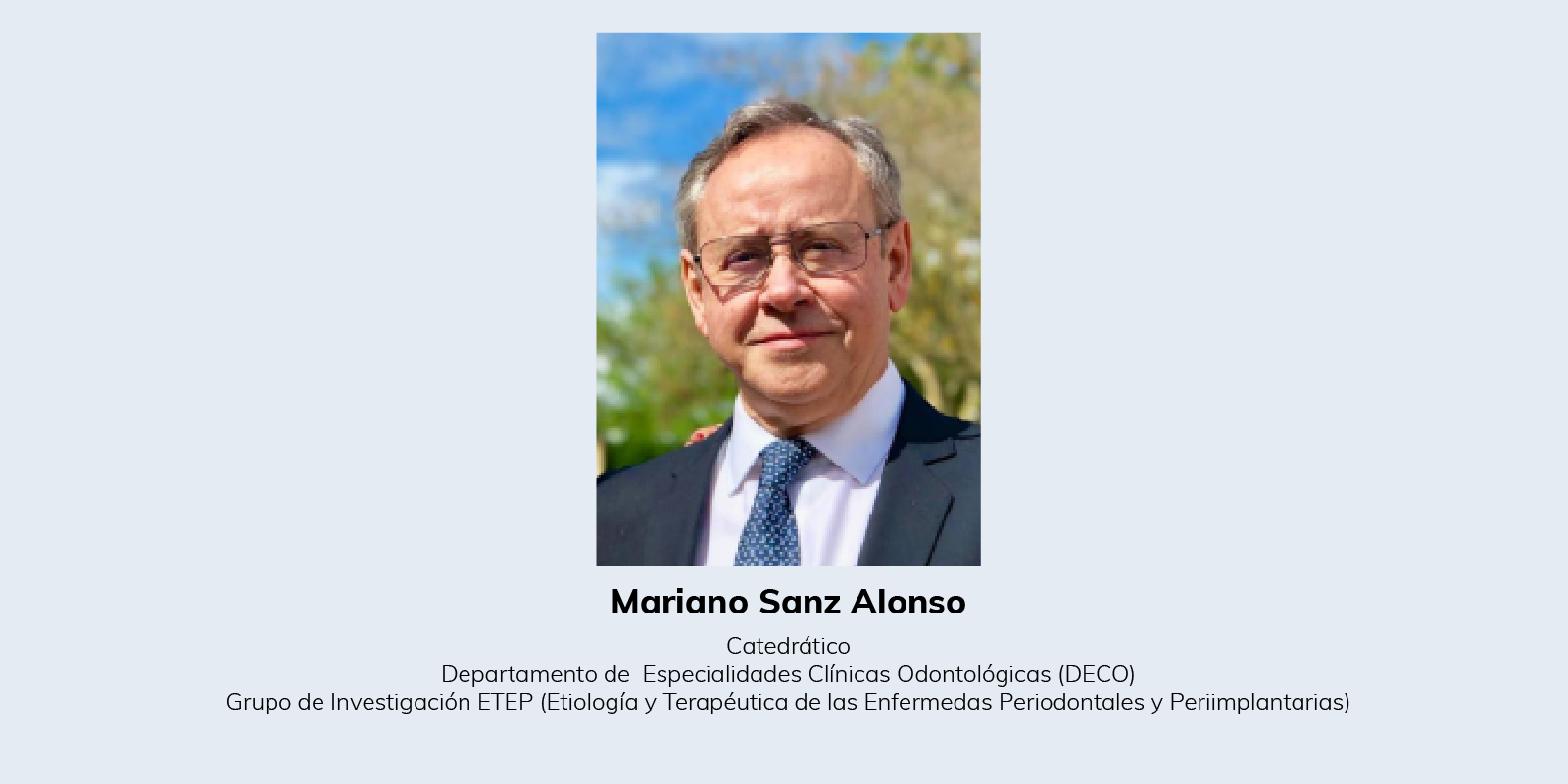DENTAID EXPERTISE
News for dentistry professionals
IAIN CHAPPLE, head of the School of Dentistry at the University of Birmingham, UK
29 Nov 2018

Iain Chapple, currently one of the world’s most renowned dentistry experts, talks to us about the new classification of periodontal diseases, about their association with other diseases and about how they can be prevented through diet.
Professor Iain Chapple is the Director of the School of Dentistry at the University of Birmingham (United Kingdom) and belongs to the university’s periodontal research group. He has published over 250 research papers and reviews in scientific journals and has written and edited seven textbooks and 16 book chapters in the fields of periodontology, medicine and periodontal surgery, nutrition and molecular methods.
Furthermore, he led the working group on periodontal health and gum diseases and conditions of the 2017 World Workshop on the new Classification of Periodontal and Peri-Implant Diseases and Conditions.
Why was it necessary to update the classification of periodontal diseases?
The last classification system was published in 1999 and advances in knowledge and understanding over that 20-year period have been significant. There had been only patchy uptake of the 1999 classification and we had an undesirable situation where different studies of disease prevalence across the international arena, all employed different case definitions. There was no consistency in approach and comparing disease prevalence and therapeutic interventions between studies was almost impossible.
Achieving a global and uniform system was one of our major aims at the outset, to ensure a common international language was established and that public health monitoring studies could be compared across the globe. We also needed a simple system that could be used day-to-day in general practice.
Which are for you the main points of the new gingivitis classification?
We have agreed that “pristine health” is not normality as it is so rare, and for the first time we have a pragmatic definition of clinical health, which allows up to 10% bleeding sites but no pocketing of 4mm or greater at those sites. Gingivitis is either “plaque-induced” or “non-plaque-induced” and we have reduced the number of plaque-induced gingivitis categories to those on an “intact” and those on a “reduced” periodontium.
There is a recognition that a reduced periodontium may arise due to previous periodontitis or for other reasons, and we define predisposing factors (local risk factors) or modifying factors (systemic risk factors). We define localized verses generalised gingivitis, and most importantly we distinguish between “sites” of gingival inflammation and a “case” of gingivitis. We emphasise the importance of risk assessment in that once someone is a periodontitis patient, they remain one for life due to their high risk status.
However, with successful treatment they may become a “case of health” in a successfully treated and maintained periodontitis patient. We also distinguish case definitions for epidemiological surveys of disease prevalence from those used for individual patients. Finally, we developed a new system for categorizing non-plaque-induced periodontal diseases and conditions.
Which might be the systemic inflammatory consequences of a contained gingivitis lesion?
The term “contained” gingivitis lesion, refers to the fact that the inflammatory processes do not involve the periodontal ligament and alveolar bone, i.e. the supporting structures of the teeth. However, there are micro-ulcers of the lining epithelium in gingivitis and they allow bacteria into the bloodstream during eating and tooth brushing. We know that those bacteria can activate inflammatory processes in the bloodstream including an acute-phase response and also oxidative stress by activating white blood cells. That systemic inflammation may negatively impact body organ systems.
Will we have salivary biomarkers in a near future as a chair-side tool?
We have salivary biomarkers already and many patents have been filed on these and on groups of biomarkers to define health, gingivitis or periodontitis. The challenge is two-fold, having a hand held technology and reducing costs to make such tests accessible in an affordable manner. Once that is realized, field trials and longitudinal studies can be conducted to evaluate their “effectiveness” in a real world practice situation.
Is there a direct relation between carbohydrate consumption and periodontal disease?
There is evidence that high refined carbohydrate intake drives inflammation in the body in general, but also in the gingivae specifically. There is also evidence from human and non-human primate studies that removing refined sugars from the diet, can not only reduce gingival inflammation on its own, but the less gingivitis we have, the less plaque accumulates. This is because the bacteria in the plaque require nutrients such as iron from gingival inflammation.
Can periodontitis really cause diabetes?
There are several studies now in different countries that demonstrate that having severe periodontitis increases significantly the risk of diabetes happening. More importantly, treating periodontitis well and effectively, helps to improve glycaemic control in people with diabetes. Proving causality if frequently not possible for ethical reasons, and according to the WHO (2002) is not always necessary. We do know however that treating periodontitis carefully improves glycaemic control and also reduces diabetes complications.
Can you explain us, as if we were kids, the neutrophil extracellular trap theory and its relation with periodontitis?
Our DNA is designed to be inside our cells in the nucleus, in order to make the cell work and to produce important chemicals that help us live. DNA is also sticky and if it is released outside the cell, it traps and immobilizes bacteria allowing our immune cells to kill those bacteria. However, if DNA lives too long outside the cells of our bodies, i.e. it is not removed after killing bacteria, then our body tries to reject the DNA as foreign material.
We produce antibodies against our own DNA when it is outside the cell and those antibodies may well result in damage to our tissues by accident as our immune system tries to get rid of the DNA. Periodontally diseased tissues contain lots of NETs and their DNA and we even find the antibodies to the DNA in our blood streams. This is called “autoimmune” disease.
Which antioxidants could we use to help us in the prevention of periodontal disease?
The most important antioxidant in periodontal diseases and other inflammatory diseases is glutathione. However, this cannot be ingested and has to be synthesized by the body’s cells. It can be preserved by taking in other antioxidants such as vitamins C, E and A, but such micronutrients are best obtained from whole foods. The darker the fruit and vegetable colour the more likely it is to contain high levels of antioxidants called polyphenols and carotenoids. So cruciferous vegetables (e.g. broccoli) and dark fruits such as blueberries or kiwi fruit are believed to help glutathione in its reduced and healthy state.
RELATED ARTICLES

13 Dec 2021
Daniele Puzzilli, the dentist of footballer Leonardo Spinazzola
With this pandemic, it has been seen that people pay more attention to their personal care. How important is dentistry in times of COVID-19? The…

09 Jun 2021
Prof. Mariano Sanz, EFP Eminence in Periodontology Award
What does winning the EFP Eminence in Periodontology Award mean to you? It means a lot, as I have been very active in the EFP since it was…

11 Feb 2020
Dr Alejandra Chaparro, Dentist specialising in periodontics and Chair of the IADR Chile
Dr Alejandra Chaparro, the current Chair of the Chilean division of the International Association for Dental Research (IADR), is a dentist who…
Sign up for the DENTAID Expertise newsletter
Sign up for the newsletter